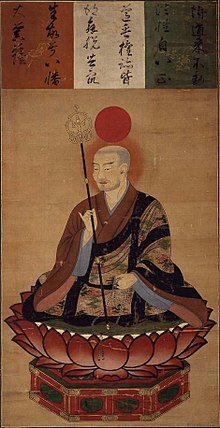Hachiman
Hachiman ( Japanese 八 幡 ) is a popular Japanese god who is worshiped in both Shinto and Japanese Buddhism . In the almost 1200 year history of his worship, the kami - Buddhist syncretism ( Shinbutsu-Shūgō ), which is typical of the Japanese religious history, is particularly evident .
Hachiman is very often identified with the legendary Ōjin -tennō, which is why the parents of the Ōjin-tennō, the Chūai -tennō and the Jingū -kōgō, or his son, the Nintoku -tennō, are often venerated in his shrines . The exact origins of this identification are not clear, there are a variety of different theories.
history
Originally, Hachiman was a god indigenous to the western main island of Kyushu . The center of his cult was above all the Usa Hachiman-gū in Usa , as well as five other shrines ( gosho betsugū ): the Daibu Hachiman-gū in the province of Chikuzen , the Chiriku Hachiman-gū in the province of Hizen , the Fujisaki Hachiman-gū in the Higo Province , the Nitta Shrine (Nitta-jinja) in Satsuma Province and the Shō Hachiman-gū in Ōsumi Province .
However, it was quickly integrated into Buddhist beliefs throughout the country as early as the Nara period (around the eighth century). During the construction of the Buddhist temple Tōdai-ji in 745 in the then capital of Japan , Heijō-kyō ( Nara ), according to the report of the high priestess of the shrine of Usa, Ōga no Ason Morime, who had traveled to Heijō-kyō at the time, Have stood by Hachiman to help. In 781, Hachiman was given the title of Gokoku reigen iriki jintsū daibosatsu ( 護 国 霊 験 威力 神通 大 菩薩 , English: the land of protective, miraculous, powerful grand bodhisattva ) by the imperial court . Artistic representations of the following period mostly show him as a Buddhist monk, and Shintō shrines for Hachiman now increasingly functioned as protective shrines ( chinjusha ) for nearby Buddhist temples (e.g. for the Daian-ji , the Tōdai-ji, the Yakushi- ji and the Tō-ji ).
From the end of the 11th and beginning of the 12th century, Hachiman became the clan- Kami ( ujigami ) of the noble Minamoto or Genji . In this function he was revered more as a god of war , with Buddhist elements taking a back seat or being left out. In the following time he developed into the general patron saint of the warrior class ( bushi ) during the Japanese Middle Ages.
On the 24th day of the fourth month in 1868, the government issued in the during the Meiji Restoration operated shinbutsu bunri (separation of Shinto and Buddhism) instructions to use the Buddhist term Daibosatsu for Hachiman at the shrines gū Hachiman-Iwashimizu and Usa Hachiman-gū banned. Instead, he was to be known as Hachiman Daijin (八 幡 大 神; "great Kami Hachiman") at these shrines .
Shrines
The popularity of Hachiman's cult is demonstrated by the fact that it is venerated in about half of the approximately 90,000 registered Shinto shrines in Japan. Of these, since they have received a corresponding bunrei , about 30,000 branch shrines of the Iwashimizu Hachiman-gū (such as the Tsurugaoka Hachiman-gū ) and 15,000 branch shrines of the Usa Hachiman-gū, together with the Hakozaki-gū, are the most popular Hachiman shrines (usually called Hachiman-gū ( 八 幡 宮 )).
Probably the most important festivals ( Matsuri ) in honor of Hachiman take place on or around September 15th every year. January 1st is an exception. In the early morning of that day, the Tennō pays homage to Iwashimizu Hachiman-gū alongside other shrines and imperial mausoleums before attending the New Year's Ceremony (Saitan-sai).
Single receipts
- ^ Jean Herbert: Shintô. At The Fountain-Head of Japan . George Allen & Unwin Ltd, 1967. p. 437.
Web links
- Satō Masato: "Hachiman Shinkō" . In: Encyclopedia of Shinto. Kokugaku-in , February 24, 2007 (English)

